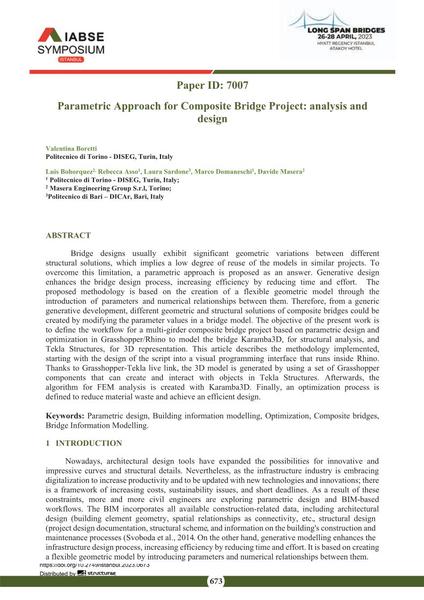Parametric Approach for Composite Bridge Project: analysis and design

|
|
|||||||||||
Détails bibliographiques
| Auteur(s): |
Valentina Boretti
(Politecnico di Torino - DISEG, Turin, Italy)
Luis Bohorquez (Masera Engineering Group S.r.l, Torino) Rebecca Asso (Politecnico di Torino - DISEG, Turin, Italy) Laura Sardone (Politecnico di Bari – DICAr, Bari, Italy) Marco Domaneschi (Politecnico di Torino - DISEG, Turin, Italy) Davide Masera (Masera Engineering Group S.r.l, Torino) |
||||
|---|---|---|---|---|---|
| Médium: | papier de conférence | ||||
| Langue(s): | anglais | ||||
| Conférence: | IABSE Symposium: Long Span Bridges, Istanbul, Turkey, 26-28 April 2023 | ||||
| Publié dans: | IABSE Symposium Istanbul 2023 | ||||
|
|||||
| Page(s): | 673-680 | ||||
| Nombre total de pages (du PDF): | 8 | ||||
| Année: | 2023 | ||||
| DOI: | 10.2749/istanbul.2023.0673 | ||||
| Abstrait: |
Bridge designs usually exhibit significant geometric variations between different structural solutions, which implies a low degree of reuse of the models in similar projects. To overcome this limitation, a parametric approach is proposed as an answer. Generative design enhances the bridge design process, increasing efficiency by reducing time and effort. The proposed methodology is based on the creation of a flexible geometric model through the introduction of parameters and numerical relationships between them. Therefore, from a generic generative development, different geometric and structural solutions of composite bridges could be created by modifying the parameter values in a bridge model. The objective of the present work is to define the workflow for a multi-girder composite bridge project based on parametric design and optimization in Grasshopper/Rhino to model the bridge Karamba3D, for structural analysis, and Tekla Structures, for 3D representation. This article describes the methodology implemented, starting with the design of the script into a visual programming interface that runs inside Rhino. Thanks to Grasshopper-Tekla live link, the 3D model is generated by using a set of Grasshopper components that can create and interact with objects in Tekla Structures. Afterwards, the algorithm for FEM analysis is created with Karamba3D. Finally, an optimization process is defined to reduce material waste and achieve an efficient design. |
||||
| Mots-clé: |
ponts mixtes
|
||||
